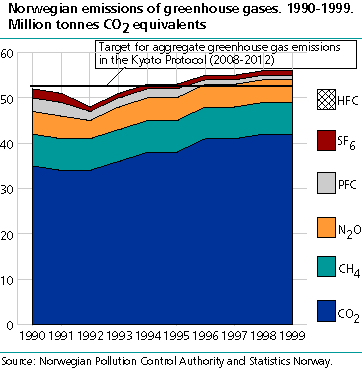Content
Published:
This is an archived release.
Greenhouse gas emissions continue to rise
Total emissions of greenhouse gases in Norway went up 2 per cent from 1998 to 1999. Emissions of CO2 increased by 1 per cent. Total greenhouse gas emissions rose by 9 per cent from 1990 to 1999, according to preliminary figures from Statistics Norway and the Norwegian Pollution Control Authority.
Through the Kyoto Protocol, Norway has pledged not to let its greenhouse gas emissions increase by more than one per cent of the 1990 level during the period 2008-2012.
The rise in CO2 emissions since 1998 is mainly due to increasing pollution from transport. There was particularly a major rise in emissions from air traffic (more than 10 per cent) as well as diesel-powered passenger cars and heavy transport (eight per cent). Emissions from oil and gas production remained virtually unchanged. Oil production was about the same as the year before, while gas production increased. Emissions relating to power production on the Norwegian continental shelf rose by more than 40 per cent, due to the start-up of new fields and production problems. Emissions from the processing industry fell 2 per cent as a result of reduced production of certain types of chemical raw materials and ferroalloys.
Emissions from oil and gas production have made the greatest contribution to the increase in CO2 emissions since 1990, followed right behind by road traffic and combustion in industry. Emissions from household oil heating and processing emissions from production of chemical raw materials have declined, while emissions from all of the most important sources have risen. Nevertheless, the 20 per cent rise in emissions is still much lower than the growth in the gross national product (GNP) in the same period, which was 35 per cent. Norway has achieved a better energy exploitation per krone of value added in all industries. The 18 per cent rise in emissions from road traffic is particularly due to the increase in freight transport by road (more than 50 per cent). Passenger transport has increased less, about 10 per cent.
Emission of CO2 by source. Million tonnes 1990-1999
There were only minor changes in methane emissions from 1998 to 1999. However, they have gone up 10 per cent since 1990. Greater emissions from the loading of ships with crude oil have contributed the most to this increase, followed by agriculture and waste-disposal land fills. Measures such as the ban on dumping wet organic waste, introduction of an end-treatment tax, requirement to burn off methane gas as well as source separation and recycling of waste have nevertheless curbed the growth in emissions.
Nitrous oxide emissions rose by 5 per cent from 1998 to 1999, mainly as a result of increased emissions from the processing industry. However, emissions from this industry fell in 1990. On the other hand, as a result of the growing emissions from road traffic - an undesired side effect of the fact that more and more cars now have catalytic converters - total emissions of nitrous oxide have increased by almost 4 per cent since 1990. Statistics Norway collaborates with the Norwegian Pollution Control Authority on preparing statistics on emissions into the atmosphere. The final emission figures for 1999 broken down by source, industry and municipality, will be ready near the end of 2001.
This page has been discontinued, see Emissions to air, Annually.
Contact
-
Trude Melby Bothner
E-mail: trude.melby.bothner@ssb.no
tel.: (+47) 40 81 14 25
-
Berit Storbråten
E-mail: berit.storbraten@ssb.no
tel.: (+47) 40 81 14 23

